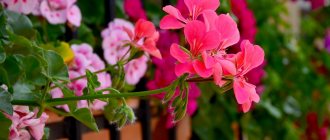Each plant is unique, and often even varieties of the same species are very different from each other . When buying a new individual, it is important to know:
- How to properly care for her;
- What will she look like when she grows up?
- And what surprises it can present to the owner.
Most Saintpaulias are similar to each other , but an individual approach to each of them guarantees an excellent result. In the article you will see a photo and description of Saintpaulia Marble Rose.
Violet Marble Rose (S. Farbitnik)
Fascinating violet Marble rose.
Marble rose is a violet of Usambor, genus Saintpaulia hybrid, family Gesneriev, class dicotyledonous, division flowering. The variety was bred by Sofia Farbitnik .
The rosette is standard size, about 25-28 cm in diameter. Sheets:
- Very dark, green shade;
- Glossy;
- Round with a heart-shaped base.
Flowering is abundant, but gradual. There are usually a lot of peduncles , and there are also buds on them, but before the next flower opens, the previous one begins to fade.
The color is fancy, the flowers are double and semi-double. The main tone is white and pink with a crimson-red marble pattern.
The size of the flowers is large, up to 7 cm, but the more abundant the flowering, the smaller they are.
The variety is resistant to difficult conditions , and even in the heat it blooms successfully, producing 2-3 peduncles with a bunch of buds. The variety is not slow to grow, but the young plant requires attention.
Attention! The first flowering is usually sparse and reaches its maximum extent at least by the third time.
White violets
Saintpaulia, or Uzambara violet Winter Lace (In memory of Tanya Makuni / Vologda)
The flowers are large, semi-double, white with a wavy edge.
Saintpaulia Winter Lace
Saintpaulia, or Uzambara violet Balchug Yeti (I. Milekhin)
The flowers are white with a blue eye and a thin border. Miniature.
Saintpaulia, or Uzambara violet RS-Mavka (Repkina)
The flowers are simple or semi-double, white with cream strokes and a greenish edge.
Saintpaulia RS-Mavka (Repkina)
Caring for a plant at home
In matters of care, the Marble Rose is not demanding. Flowering responds to certain maintenance parameters by changing the size and color of flowers.
For good flowering, the variety requires proper care.
Conditions of detention
Violets naturally grow in warm, humid forests. The main conditions for good growth and flowering of the rosette are :
- Lighting – Saintpaulias prefer a lot of light. The lighting should be bright but diffuse. With the natural option, you need to avoid direct sunlight on the flower. Daylight hours are:
- In summer – 12-14 hours;
- In winter – 8-10 hours.
- Temperature – the mode completely depends on the season and the needs of the flower:
- In summer it is maintained at 24° ± 2;
In winter about 18° ± 2.
During transition seasons the temperature changes gradually ; sudden changes should be avoided;
Important! Sometimes, when growing exhibition specimens, flower growers change seasonal flower care. There are cases when the temperature regime and the length of daylight are adjusted depending on the behavior of the individual, so in winter conditions that are characteristic of summer can be maintained.
- Air humidity – Saintpaulias need high humidity. It is important to adjust the moisture level depending on the temperature; the colder it is, the lower the humidity should be and vice versa, an increase in temperature allows for a higher percentage of moisture;
You can collect soil for violets yourself. - Priming – in nature, violets grow on very light and breathable soils. When planting in a pot, it is better to give preference to specialized substrates. If you prepare it at home, you need to mix:
- 3 parts peat,
3 parts primer,
- 3 parts perlite,
- 2 parts sphagnum moss.
For wick irrigation, use a mixture of peat and perlite in equal parts without adding other components.
Watering and fertilizing
The watering regime is very important, and you need to remember that water ingress:
- May leave burns on leaves;
- And at the point of growth cause rotting.
Three methods of watering are used , on which the frequency of fertilizing depends:
- In a tray - the pots stand on a tray or trays 1-1.5 cm deep, and water is poured there, after watering the remainder is drained. The concentration of fertilizers for such irrigation should be half the recommended one. Watering frequency is on average once a week, and fertilizing every other watering;
- Under the leaves - water is poured through the soil, avoiding contact with the leaves. The frequency of watering and fertilizing conditions are the same as in the previous method;
- Wick – a wick is placed in a pot, removed through the drainage holes and lowered into a container of water. Fertilizers are constantly added to the water in quantities that are 7-8 times less than recommended.
Transplantation, pruning, rejuvenation
Young plants are regularly replanted , as they grow, usually they are simply transferred to a larger pot. Adult Saintpaulias are usually replanted once a year, with a complete replacement of the soil.
Saintpaulias need to be replanted once a year.
When replanting mature flowers, they are usually pruned and rejuvenated . First of all, remove the old ones:
- Leaves;
- Peduncles;
- And roots.
Leaves and peduncles are trimmed as needed, regardless of transplantation. If the rosette has aged or the stem has become very long, it is cut off by removing the lower part . If roots remain on the rosette, it is simply replanted, and if pruning occurs high, then the top is first rooted.
Varieties
Pink violets are the most popular, and therefore breeders have developed a great variety of varietal violets with this color. Few people can give a descriptive description of all varieties, but there are varieties that stand out from the rest with their unique characteristics.
"Pink Watercolor". Belongs to the most beloved flower growers and popular varieties. This culture appeared thanks to amateur breeder Konstantin Morev (Russia). The background of the petals is pale pink, almost white, with strokes on it, as if they were painted with watercolors. The edges of the petals are in the form of waves, the outer side is slightly curled, outwardly similar to the fringe of a terry structure. The color of the leaves is rich green, excluding the outer edge, it has either a light beige or white color.
"Pink Panther". The flower has large flowers of light pink color, their white petals have edges in the form of waves that are clearly defined. The leaves are oval-shaped, their outer ends are pointed, the edges are lacy, the color is uniform green.
"LE-Pink Marshmallow." They are compared to airy marshmallows, which are covered with berry puree. The flower has a fairly compact and neat rosette, consisting of large oval-shaped leaves, painted green, with milky beige edges. The peduncles are strong, vertical, bear large flowers, up to six and a half cm in diameter and have a deep pink color. The older the flower, the richer the color of the petals.
"RM-Pink Curls." The variety is distinguished by flowers that look like stars with wave-shaped edges. The flower is quite large in size, formed by pink petals, shimmering in a soft purple color, with corrugated edges. The peduncles are tall, each usually bearing four to five buds. This variety blooms profusely and for a long time.
"RM-Pink Wave". This varietal violet resembles the previous variety in appearance. And this is understandable, since the variety is the parent of the “RM-Pink Curls” variety. The flowers resemble stars with wave-shaped edges. The background of the petals is deep pink; on it you can see yellow stamens, which are collected in a random circle. The cap of flowers is surrounded by an even rosette of green leaves. This plant grows quickly, blooms early and for a long time.
"PT-Pink Clouds". This variety has large flowers of soft pink color and carved oval-shaped leaves. Blooms profusely in the shape of a cap. The leaves are deep green on the outside and lighter on the inside; they form a compact rosette.
"AV-Pink Roses." The variety is distinguished by large flowers that resemble a rose in appearance. Above the rosette, consisting of dark green leaves, are pink flowers with a crimson border. The plant blooms profusely.
"EK-Pink Dalmatian." Differs from most varieties in the original color of the flowers. The background of the petals is pink-lilac in color, with spots of raspberry-lilac color randomly scattered across it, as if the flower had been sprayed. The flowers are rich and stand out perfectly among the dark green leaves. The background of flowers is the same tone, has small stains of lilac-violet coloring. The variety blooms early and actively.
Rob's Antique Rose. Semi-miniature variety. The leaves are dark olive in color, the edges have teeth, thanks to them a fairly neat and even rosette is formed, above which there is a very decorative cap of flowers. The main background is pink in color, shimmering with silver, closer to the middle there are strokes of crimson, sometimes cherry color, their edges are slightly blurred, the border is rich light green.
Joy's Pink Halo. A miniature variety that blooms for a long time. The flowers look like bells, which open fully as they grow older. The leaves in the middle are dark green in color, and pinkish-beige along the edges; they form an even rosette, above which there are elongated pink flower stalks, each bearing up to nine flowers. The flower grows slowly and blooms for a long time.
"LE-Pink Muscat". The variety blooms profusely and for a long time. The rosette is even, consists of oval-shaped leaves with a dark green color, above it there are elongated persistent peduncles with buds of unusual shape and color. The petals are pink in color, slightly cast in bronze, their border is darker, has a green tint, they form oblong buds that resemble bells in appearance. In an adult violet, the color of the border is almost beige.
"LE-Pink Dreams." This variety has large flowers and a small rosette. Externally, the flowers are similar to roses. The flowers are quite large, soft pink in color, have bright pink edges with a terry structure, and form a loose but very decorative cap.
"LE-Pink Cascade". A semi-miniature variety that was bred by E. Lebetskaya. The flower has large leaves that are pointed at the ends and pink flowers with a slightly wavy border. The leaf is similar to a variegated rug: strokes and patterns of green, white, and pink colors decorate its upper part. The succulent rosette plays perfectly in contrast with the pink flowers located on elongated peduncles.
"EK-Pink Eschscholzia". The variety is popular for its large semi-double flowers. Wide petals of deep pink color. The leaves are bright green, their edges are jagged, the foliage forms a neat rosette. The bush blooms luxuriantly.
"Allegro Pink Pistachio". The variety blooms for quite a long time. The flowers are green in color, have a bronze-red border in the form of a wave and petals, distinguished by small fuchsia-colored rays on them; the flowers grow to a small size (three to four cm). Peduncles can bear green or pink flowers, it depends on the lighting and temperature conditions. Good illumination changes the color of the border and rays, they become burgundy in color. Where the sun shines well, the color of the border becomes brighter and becomes red-brown.
"Sunkissed Rose" The most original and unpredictable violet variety. In ordinary varieties, the rosette is made up of very large leaves with wave-shaped edges. The elongated petioles of the leaves form a large rosette in diameter (up to twenty-seven to twenty-eight cm). The flowers resemble stars, have petals with velvet edges in the form of waves, and are small in size (three to four cm in diameter). The color of the flowers may vary, depending on the stage of flowering and growing conditions. When the buds begin to bloom, they are white in color; when they grow and increase in size, the color changes. The petals closer to the middle turn yellow, and the wavy edges become dark pink. When the plant finishes blooming and the yellowish-pink background becomes darker and turns red.
"Rebel's Rose Bud." The variety was developed by foreign breeders; it is unpretentious and very decorative. The flowers are large in size, soft pink in color, the petals have a terry border of a bright pink shade, the flowers form a rather lush cap. The leaves are elongated, pointed at the ends, form a smooth rosette, are painted on the outside in a rich green shade in the middle, and have a white border with a pink tint.
"Rose Bouquet" The plant has variegated mosaic leaves and small flowers with velvet edges. The leaves are oval-shaped, smooth at the top, quilted, forming a small but compact rosette. The flowers are pink in color with a dark center, are on elongated peduncles, and form a loose, however, very decorative cap.
"Pink Mint" Miniature violet variety. The leaves are small, in the shape of a triangle, painted green, form a dense bush, above it on elongated peduncles there are pink flowers with edges of a terry structure, resembling a bell in appearance. The variety blooms profusely. Numerous buds are formed and do not open for a long time, especially in young vegetation.
"Pink Dove" Miniature violet variety. Small (two to two and a half cm) pink flowers have sail-shaped petals, in the center they rise above a compact and very decorative rosette, which consists of variegated leaves of a dark green color in the middle and having a border with pink specks. The variety blooms in waves, lasting from two to two and a half months.
"Ness' Satin Rose". This is a slow-growing variety; in addition, flower stalks form and buds bloom for a very long time. The flowers consist of petals that are pink in the middle and have a lilac-silver border. The flowers form above a rosette of dark green color, with a slightly bluish-whitish tint, a decorative bouquet that blooms for a long time. The rosette is twenty cm in diameter, but the leaves are small, their size is formed using a species characteristic - elongated petioles.
"Rose Cheeks" Decorative miniature variety. Blooms profusely. The peduncles are strong, long, and bear flowers that resemble compact roses. The bouquet is compact, dense, dark pink in color and stands out among the dark green leaves that form a neat little rosette.
Edee's Rosebud Trail. The variety blooms regularly and profusely, and it also grows quickly and is undemanding to care. The leaves are variegated, the flowers are pink and have a peach tint.
"Rose Garden". The variety grows slowly. Young bushes begin to bloom only after 1.5 years. This is a semi-miniature variety with a neat rosette, which consists of green leaves with teeth along the edges, and elongated peduncles, on which there are flowers of a soft pink color, reminiscent of bells in appearance. Thin and elongated peduncles cannot hold the flowers vertically; they are located on the leaves, and the buds lie a little lower from the rosette. This is a sign of the variety.
"DS-Pink." Blooms early and almost constantly. The flowers resemble bells in appearance and have a very original color. The background is a deep pink color, on which chimeric shades extend from the middle to the edge of the terry structure - blue rays with small specks of pink color. The peduncles are elongated and powerful, perfectly holding quite large flowers.
"Emerald Pink" The variety blooms constantly and for a very long time; some flowers do not fade for ten to eleven months. The flowers are in the form of cups, peach-pink in color, with a green border; when the plant finishes blooming, they lighten. The young flowers have a background of light pink petals with mother-of-pearl. The flower has a compact, even rosette, twenty to twenty-five cm in diameter.
"Cajun's Roses Anyone." This variety has heart-shaped leaves, painted in dark green and having a creamy-pink border, as well as plump flowers of a soft pink color, reminiscent of porcelain. The flower stalks are powerful and quite prolific, each bearing almost five to seven buds, located above a small, up to twenty-two cm in diameter, but very decorative rosette.
Features of flowering, growth and reproduction
Marble rose grows quite quickly:
- From baby to adult it takes about 10-12 months;
- And the first flowering occurs even earlier.
This variety blooms very profusely, but it is very difficult to achieve bouquet or cap flowering from it . This is due to the gradual blooming of flowers. Peduncles:
- Powerful;
- Medium height;
- Each one contains many buds.
But while the next one blooms, the previous one fades. Each flower lasts about a week, sometimes longer.
Depending on the lighting, the color of the flowers may vary slightly:
- The warmer and more light, the darker the flowers become and the less noticeable the pattern;
- And when the temperature drops and the lighting dims, the pattern is clearer and the light parts are larger.
Important! In hot weather there may be a decrease in flower size, but this can also happen if there are a large number of buds.
Many gardeners propagate Saintpaulias by leaf.
Varietal characteristics are transmitted by all methods of reproduction :
- Leaves - healthy leaf cuttings, cut in 3-4 rows, are rooted in a convenient way. Each cutting can produce 1-3 babies, which are planted and further grown;
- Peduncles - live, not withered peduncles, cut to a size of 1.5 cm below the receptacle node and 0.5 cm above, planted in the ground under the greenhouse. After rooting and formation of the children, they are seated and then cared for like other Saintpaulias;
- Seeds - they are sown in a greenhouse, and after germination they are further grown in such conditions. Next, the children are seated in separate pots and cared for like adult violets;
- Stepchildren - stepsons are formed in the leaf axils; after 4-6 leaves appear, they are cut off and rooted. Some gardeners deepen the mother plant until the stepson touches the ground and wait for the roots to appear on the latter.
Ampelous Saintpaulias
There are ampelous types: their greenery is lush, and the stems hang over the edges of the pots. Planted in containers with loops. Such varieties have elongated and creeping stems and many side shoots.
The most popular varieties:
- Grote with voluminous leaves and purple cornflowers;
- Folin Snow with numerous small white flowers.
- Robs Hampti Doo with light green and pearl flowers;
- Ramblin Dots with white and gold leaves and lavender buds covered in a purple pattern;
- Summer Skies keychain with malachite round leaves, bluish buds;
Reviews
Alexandra. “The variety is very persistent and unpretentious. After the purchase, I quickly got used to the conditions in the apartment and the new type of watering (switched to a wick). The first flowering was very pleasing. The flowers were immediately large, but it produced only two peduncles of 3 flowers each. The second time there were a lot of flower stalks, but it was either hot or there were a lot of buds, but the flowers became a little smaller.
Marble rose is a very simple variety to propagate. I practice only leaf cuttings (stepchildren spoil the appearance of the rosette; seeds and flower stalks are very difficult). I had 2-4 children on each sheet, which made me very happy.”
Igor Sergeevich. “This variety has proven itself very well. Despite the lack of special care, the rosette is very beautiful, and the flowers are large and fluffy. I just started propagating, I put the leaves in moss on a wick, the first roots have already appeared. For three years now I have been trying to get cap flowering from it, but so far without success. It’s important to me that the Marble Rose is not afraid of heat, because in my summer it’s very hot and a lot of Saintpaulias just disappear.”
This variety has captivated many gardeners with its beauty.
Pink violets description and characteristics
Saintpaulia from Africa is a herbaceous perennial. The stems are shortened, form a circle around the rhizome - a rosette, and have succulent heart-shaped leaves that are covered with pile. The leaves are usually one green color; in rare cases, you can find varieties whose foliage is spotted, as it has specks of a different color. The flowers consist of five petals, their edges are flattened, slightly curved or in the form of waves, the flowers are collected in tassels, covered from below with five sepals.
To make it easier to perceive Saintpaulias, they are called violets, despite the fact that the color of their petals is not only purple. Thanks to the work of breeders, a large number of violet plants of different types, sizes, and colors are known; their detailed characteristics can be found in literary sources.
Diseases and pests
If the conditions of maintenance and care are violated, the following may occur:
- Rot;
- Late blight infection;
- Powdery mildew;
- Burns.
Also, violets are not immune to some pests , for example, spider mites.
To avoid illness, it is important to strictly follow all the rules of care and remember:
- Overwatering leads to rot;
- Late blight and powdery mildew - develops in cold and very wet conditions;
- Burns occur when exposed to direct sunlight or dew drops on the leaves.
Popular varieties of garden violet (viola)
All varieties are frost-resistant and light-loving. The most popular of them are:
Abendglut
Forms a dense shrub up to 20-25 cm high. The foliage is blue-green. The buds are cherry-shaped, pleasantly fragrant, reaching 6 cm in circumference. The lower 3 petals have bright red-brown spots. Flowering can be observed in April-May and again in the fall.
Adonis
Green with a slight herbaceous tint. Lemon-colored inflorescences (13-15 pieces) grow on a high stem 16-18 cm. Blooms in May.
Goldenkrone
Compact shrub up to 18-20 cm high. Buds are golden-canary in color. Their undersides are slightly wavy, with dark brown spots. Appears from April to June, reappearing in the last month of summer.
Gent Oregon mixed color
Grows up to 20-23 cm. Green - emerald. Inflorescences are red-yellow. The petals are wavy, the upper ones are wine-red, the lower ones are sunny with a purple pattern and a dark scarlet border. Flowering can be observed from April to August, many times in the first month of autumn.
Candidissima
A small shrub up to 20-23 cm. Blooms profusely from April to late spring. The flowers are white with a pleasant aroma.
Mars
Dense shrub with dark green leaves. The buds are dark blue, fragrant. The underside is curved, with dark amethyst, almost black spots. There are 24 flowers open at a time on a flower stem. Their flowering period: early spring, they appear again in autumn.
Jupiter
With dark leaves, up to 15-16 cm high. The upper petals are snow-white, the lower ones are purple-lilac, velvety. Blooms in the second decade of spring.
Bambini
One flower has several shades: sunny, pinkish, wine. In the center are black eyelashes.
Vittroka Terry lace
The inflorescences are light cornflower blue with a wide black stripe. Up to 8 cm in circumference.
There are many varieties of home and garden violets. Any lover of flowering plants can choose the variety to grow according to their tastes. For beginners, it is better not to choose collectible species, since caring for them requires certain skills and knowledge. It is recommended to start with dwarf or ampelous specimens. They are easier to handle and also very attractive and fragrant.











